Please visit our new site
Scientific-Industrial Enterprise Biotechnology,
Ltd.
(The SIE Biotechnology, Ltd.)
The Scientific-Industrial Enterprise Biotechnology, Ltd. (SIE
Biotechnology, Ltd.) was organized in 2004 for the manufacturing
of ecologically pure organic fertilizers. Technological process is based
on modern scientific achievements dealing with the utilization of cattle
manure and straw and recycling these biowastes into organic fertilizers.
There is one of different ways for processing of cattle manure and straw
and recycling of biowastes into organic fertilizer such as a vermicompost.
This fertilizer is a result of biotechnological process called vermicomposting.
This process differs significantly from a traditional way of composting.
Firstly, the common composting has only one stage. Secondly, there are
no inexorable technological requires demanding both input material and
composting process. Thirdly, according to consumer properties vermicompost
(i.e., biohumus) is an absolutely ecological pure product and 20 times
more effective than ordinary compost and 80 times in comparison with cattle
manure.
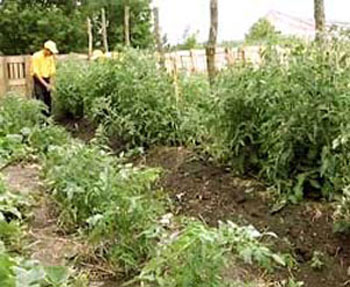 Photo 1: Tomatoes, grown with biohumus - on the right side; Tomatoes, grown without biohumus - on the left.
Photo 1: Tomatoes, grown with biohumus - on the right side; Tomatoes, grown without biohumus - on the left.Biohumus is used as a basic fertilizer in the whole period of vegetation. These and other data about the efficiency of biohumus application are confirmed by field and laboratory experiments fulfilled at the Department of Soil Science and Agrochemistry, Rostov State University (Rostov-on-Don, Russia) and are not contradicted to results obtained in different countries abroad.
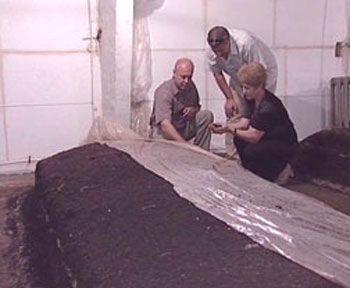 Photo 2: O.S. Bezuglova, Professor of the Department of Soil Science
and Agrochemistry, Yu. V. Bojkov, Director of SIE Biotechnology
and A.M. Bibik, Vice-Director are drawing compost samples for investigations.
Photo 2: O.S. Bezuglova, Professor of the Department of Soil Science
and Agrochemistry, Yu. V. Bojkov, Director of SIE Biotechnology
and A.M. Bibik, Vice-Director are drawing compost samples for investigations.
Additionally, the biohumus water extract (BWE) technology was
worked out and was introduced by engineers of the Scientific-Industrial
Enterprise Biotechnology, Ltd. This fertilizer (i.e., BWE
Donskoi) is recommended as a basic organic fertilizer during the
autumn bedding and supplementary fertilizing for all kinds of agricultural
cultures. Our product can be used starting from seeds preparation and
during the whole period of plant vegetation.
The Vermicomposting Process
The vermicomposting is a two-stage process of the input organic material
destruction and the transformation of a biowaste mixture consisting of
cattle manure, straw and/or residues of sunflowers into the high quality
organic fertilizer such as biohumus Donskoi.
Technological Description of the Biohumus Donskoi Development
The First stage: Fermentation
At the first stage, on a fermentation site insulated from a stowage of a cattle manure and straw of grain crops, in strictly definite proportions, the special mix (i.e., substratum) is prepared of input organic materials (manure and straw) . The mixture ratio is determined after realization of own laboratory researches on quality of basic materials at their entry on a storage site.
Parameters determining the quality of basic materials are the following:
- Total content of organic carbon;
- Total content of nitrogen;
- Content of phosphoric acid (P2O5);
- Content of potassium (K2O);
- Content of protein;
- Ratio C:N;
- Moisture content;
- Acidity (pH index).
On the basis of the research data obtained the mixture consisting of input materials moves into the mixing machine in the counted proportions, where there is a final mincing and homogenization of substratum (to mix to a homogeneous condition). After that in a strictly definite order and with observance of definite methods this organic mixture is graded stacked in clamps, and then it is wetted and covered up.
 Photo 3: The organic mixture is being graded stacked in clamps. In the background – the worm container (external view)
Photo 3: The organic mixture is being graded stacked in clamps. In the background – the worm container (external view)Within 3-4 days from the moment of stacking the temperature inside a clamp is increased up to 65-70° C due to aerobic conditions. In such regime this clamp with a substratum is maintained during 8-10 days. At this time in this substratum a complex of physico-chemical and microbiological processes are developed. High temperature and interspecific antagonism of microorganisms provide a decontamination of the substratum from a pathogenic microflora (intestinal bacillus, salmonella, eggs of helminthes, etc.).
According to a technological scheme, in 10 days the substratum is again moved in a clamp to provide the recycle process in external layers that were not subjected to the heat treatment. As a result, this procedure is weekly repeated 5-6 times. During this period not only the substratum decontamination takes place but also the development of useful microorganisms. These biotas provide the first stage of substratum utilization into compost with a good quality.
To accelerate the fermentation process we developed a number of bacterial extracts, application of which ones reduces essentially a time needed for preparation of a substratum from 2 months to 1 month in the summer and to 1.5 months in the winter. At the end of the process laboratory researches determining a degree of the substratum availability and a necessity of correcting measures are being carried out. After the substratum has reached technological parameters of availability, it is being transported on the end product storage site. This site must be insulated from the fermentation site.
The second stage: Vermicomposting
The vermicomposting is a complex process of internal fermentation of the prepared substratum in the gastrointestinal channel of technological breed of earth worms. This process is characterized by that after the creation of a definite microclimate the substratum is a nutrition component for the specially developed domestic breed of earth worms "Staratel".
Using the substratum, i.e. passing through their own gastrointestinal channel, the earth worms “Staratel” enrich the environment by soil microorganisms and enzymes. Therefore, the concentration of useful properties of prepared substratum is improved according to natural technology. As a result, we have volume of substratum utilized as a new end product which is called as biohumus.
Biohumus is an organo-mineral mass with black or brown colour and without smell. According to physical and chemical properties, it looks like a fertilized soil with unique features such as ecological purity including atoxicity for plants in the case of high dosage. As a result, biohumus is absolutely safe for people and bees.
|
Photo 4: General view of biohumus |
Photo 5: General view of the end product
packed
and without package. |
The vermicomposting is developed on our enterprise in a worm container worked specially out for this purpose. See photo below:
|
Photo 6: The interior of a worm container |
Photo 7: The cultivation of clamp with earth worms |
This gallery is a thermos made of heat-insulation material, total square is 500 m2. Clamps of prepared substratum and after that colonized by the earth worms bread “Staratel” are located on a concrete floor.
Photo 8: The technological breed of earth worms Staratel into substratum
The production efficiency depends on total quantity of earth worms, substratum properties and the following environmental factors such as temperature, moisture, acidity, noise and illumination. The raw biohumus, received at the final stage, is moved to future humification (i.e., temporary ageing) and for air-drying and after that it is sieved on different fractions and is packed.
Photo 9: The scalping of raw biohumus
Abstract of biohumus water extract Donskoi technology
Biohumus water extract Donskoi is a result of water extraction
of humic substances (i.e., humic and fulvic acids) from biohumus Donskoi
according to the method of the Department of Soil Science and Agrochemistry,
Rostov State University. At the first stage of extraction fulvic acids
and microflora are separated from biohumus. At the second stage an extraction
of humic acids is executed. The received concentrate is filtrated and
investigated for the total content of humic substances. Depending on laboratory
data, this concentrate is diluted with water to a necessary condition
and then is mixed with fulvic acids extracted at the first stage. At the
final stage microflora is added to the extract. The end product is being
bottled.
Advantages of this new method allow to include not only humic and fulvic acids, but enzymes and microorganisms of initial biohumus. The end product is a liquid with a colour from light-brown to dark-brown and with low alkalinity. The water extract of biohumus Donskoi has an ecological purity including atoxicity for plants in the case of high dosage. As a result, this product is absolutely safe for people and bees.
Working Area
To achieve this goal a building of a former grain store house amounting to 3000 m2 was rented. The building is a construction of concrete walls and slab, a heat-insulated binary housetop and two gates.
Housing dimensions:
Length - 120 m
Width - 25 m
Apex height - 8 m.
In addition to the worm container there is an office, a laboratory and storage inside housing.Space distribution scheme is given below:
- moving direction of non-decontaminated substratum;
- moving direction of decontaminated substratum and biohumus;
- moving direction of finished product.
Equipment
This production type had not been developed in the former USSR and in new Russia till 2000; as a result, specialized equipment for vermicomposting was not produced. Therefore acceptable standard equipment is used in vermifarms or their own specialized equipment is constructed. In our case the majority of operations are manual. However, the following units have been produced lately and are used now:
- straw shredder (capacity is about 150 kg/ h);
- blending machine (capacity is about 2000 kg/h);
- vibrating separator (capacity is about 200 kg/h).
Moreover, on the basis of acquired experience we are creating a fermenter that will allow us not only to reduce substratum preparation time and to improve quality but it will also shorten working hours on intermediate re-clamping.
Productive Capacities
1. Production of biohumus Donskoi.
Today’s production basis condition of the worm container in theory permits to receive from 50 to 100 m3 of biohumus per month. Vermiculture (worms “Staratel”) being the main instrument is capable to convert as much substratum as it weighs; hence, the more worm abundance the larger yield is. Under certain conditions worm number can be increased 1.5- 10 times within 3-4 months. But in reality productive capacity is limited by productivity at the fermentation site and amounts to 10-20 m3(taking into account unsatisfactory processes mechanization of substratum preparation – huge expenses of time, intermediate re-clamping). Productivity has been also decreased significantly through lack of a specialized dryer. Moisture capacity of biohumus is determined by high natural hydroscopicity and comes to 100 % that is it absorbs as much moisture as it weighs. Under natural summer conditions it is possible to dry no more than 10-15 m3 of biohumus; yet the unspecialised dryer functions efficiently only in winter and has the same productivity.
2. Production of biohumus water extract Donskoi.
Theoretically water extract production is limited only by raw material availability – biohumus Donskoi. Technology already nowadays allows to make 100 000 litres of extract for agriculture producers.Real productivity is restricted to 3000 litres through lack of corrosion-resistant container with volume at least of 50 m3 for buffer extract storage.
Biohumus Production Prospects and Advantages under Project Realization on Construction of Specialized Production Complex
The presented project of biohumus and WEB production lay-out is developed with a glance of existing standard equipment produced in Russia and permits to avoid disadvantages we have faced today. Here are some principal of them:
- Facilities for receiving input raw materials permit to isolate contaminated with relation to sanitation and hygiene raw material from fermentation and vermicomposting processes; to reduce personnel contact with raw material and to gather and utilize received manure yield.
- Unproductive transportation processes with transporters’ use will decrease expenses of time and labour essentially.
- More productive devices – breaking and blending machines will also accelerate blend preparation process.
- Site for preparation of additions-accelerators allows to prepare them in necessary terms of numbers and of equal quality and to fulfil their drive feed to fermentation site.
- Fermentation site with use of loading transport machinery, for example, auger loader, will permit not only to eliminate hard manual labour when re-clamping but in addition to it to mince and blend substrate.
- Availability of an insulated place for prepared substrate will permit to have considerable content of homogeneous substrate blend with average rates that will positively affect speed of substrate processing by earth worms( worms are highly legible to aliment uniformity).
- Block insulated organization of a worm container and a queen cell will significantly reduce risks connected with worms’ diseases and provide different parameters of microclimate in the queen cell and worm container; it will also allow to reduce a stressful effect on worms – effect from human presence, light and noise in the unattended at the moment block.
- Vacuum drying proposed in this project is not only more productive but it is more qualitative.Owing to smooth inertialess control and temperature regulation it can practically eliminate humification stage having preserved at the same time the whole community of microorganisms.
- Owing to technologically well-installed capacitive equipment the site for the biohumus water extract preparing is able to deliver biohumus extract in quantities two orders above present.
- Available normal conditions for a technological laboratory will permit to improve significantly quality, quantity and timeliness of performed researches.As a result, it will improve product quality and yield.
- Power unit is a guarantee for success. Gas application as the main energy carrier will permit to smoothly regulate and maintain microclimate within the necessary range. The emergency self-contained power generator will fully eliminate risk of climate violation as environmental temperature alteration only by two degrees causes instinct actuation of escape from drastic alterations of existence conditions.
- The specialized storehouse will provide necessary conditions for production storage, preservation, qualitative control and mechanical loading and discharge.The specialized storehouse will provide necessary conditions for production storage, preservation, qualitative control and mechanical loading and discharge.
- Available office facilities in complex will permit to nimbly control the enterprise, make decisions in proper time, monitor production process; they will also provide personnel with normal working conditions.
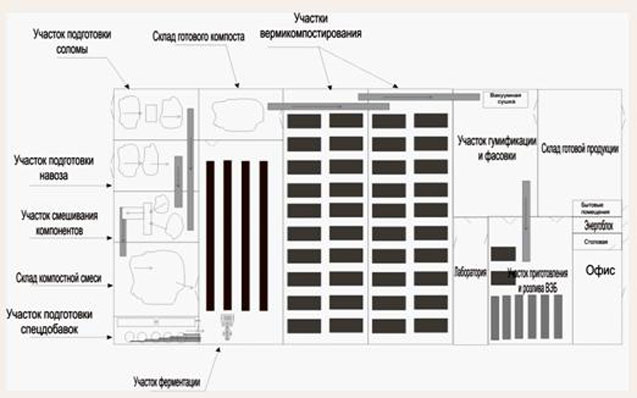 Production Complex Project for Vermicomposting with Total Area of 6000 m2
Production Complex Project for Vermicomposting with Total Area of 6000 m2As stated above, it allows to count on considerable productivity increase up to 500 m3 of biohumus and 1500 tons of WEB per month. Complex production arrangement has always contributed to reduction of costs and solution of such problems as provision of territory preservation, video monitoring of processing observance, etc.
Social Aspects of Biohumus and BWE Donskoi Output Expansion under Project Realization on Specialised Production Complex Construction
Biohumus and its derivatives particularly BWE Donskoi production provide our society with solution of many problems that cannot be estimated, perhaps, from the economical point of view. It can be only an integrated assessment. But we would like to mention some of them.
Cost saving of biohumus and BWE Donskoi production will make them available even for small agriculture producers and therefore stimulate their widespread usage. Effective adaptation of biohumus and BWE Donskoi will require changes to the organic agriculture system. It will gradually get rid of chemical, mineral fertilizers and “plant protectors”. Consequently, agriculture production will become ecologically clean and health-giving; it will function as nature – provide people with foodstuff, vitamins, etc in the natural form instead of containing mineral (read – deadly) fertilizers at their producers’ request. It is general knowledge nowadays that agriculture producers do not spare means on less expensive “mineral manure” in attempt to get harvest. As a result, at present we have half of the Mendeleev’s table in “green” packing.
Photo 10: Ecologically clean marrows and cucumbers cultivated on biohumus
Within the framework of national projects realized today in agriculture sector a considerable role is devoted to development of cattle breeding. Crediting to the development of cattle breeding will entail creation of grand cattle-breeding complexes.
It pleases us as domestically produced meat and milk are obviously much better than foreign ones.
But the question is what to do with waste substances, for instance, manure? Shall we again recommend agronomists to put manure in the fields, sow seeds of undesirable plants, populate soil with helminth eggs and pathogenic microflora? Or shall we examine world experience? There are more than 500 000 small and about 200 big specialized biohumus producers in the USA and about 400 in Great Britain.
Further enumeration makes no sense you cannot count them on the fingers of your hands.
The project was announced as usual but consequences were not considered. The project realization on specialized complex creation for biohumus Donskoi and BWE Donskoi production will allow not only to utilize up to 1000 tons of toxic cattle manure but to get about 500 tons of biohumus Donskoi for compensation exhausted after cultivating plants soil. That is to say, we realize the principle “Wastes into gains”.
But the SIE Biotechnology, Ltd. will not produce only biohumus Donskoi and BWE Donskoi. For soil rehabilitation we are planning to convert the rest thousands and millions of manure tons into soil nourishment, namely, to prepare cheap and qualitative compost. In addition to it we can say that production of high-quality compost will permit also to receive biogas in considerable amounts.
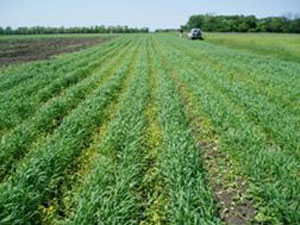 Photo 11: Barley sown according to progressive technology with BWE Donskoi usage
Photo 11: Barley sown according to progressive technology with BWE Donskoi usage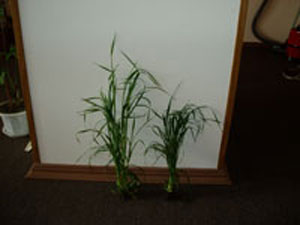 Photo 12: Barley sown according to progressive technology with BWE Donskoi use – on the left, without use- on the right.
Photo 12: Barley sown according to progressive technology with BWE Donskoi use – on the left, without use- on the right.The SIE Biotechnology, Ltd. also gathered separate pieces of information and summarized knowledge on organic agriculture. It also carried out field tests on special “organic” agriculture machinery application with an impressive result. Even now we are ready to popularize obtained knowledge.
But this following stage is to be discussed later on.
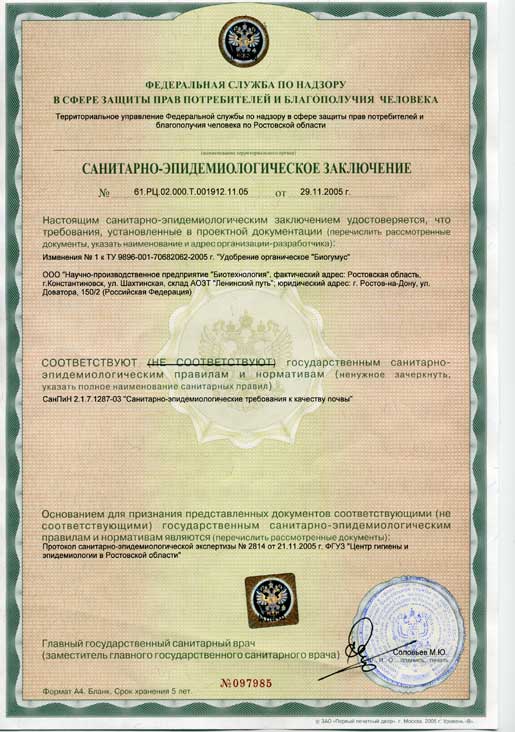 Sanitary-and-epidemiologic Certificate
Sanitary-and-epidemiologic Certificate Veterinary Certificate
Veterinary Certificate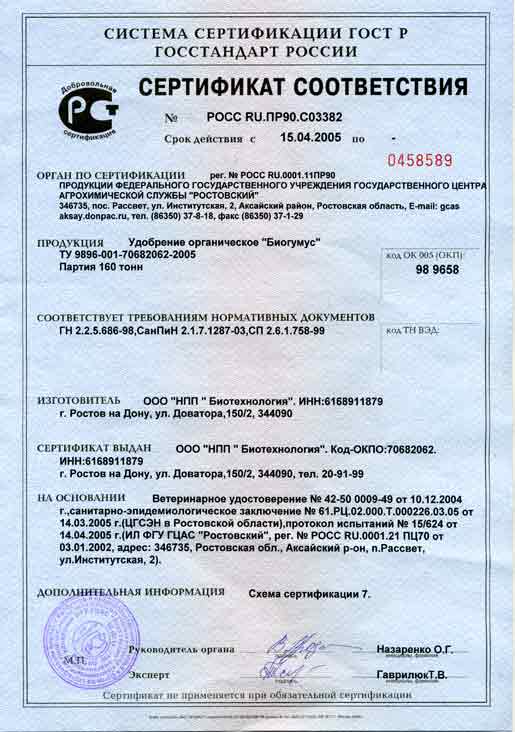 Certificate of Conformance
Certificate of Conformance |